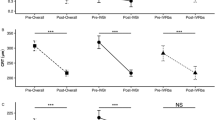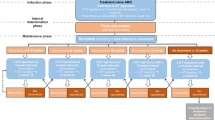Abstract
Purpose
Current algorithms for automated computer interpretation of optical coherence tomography (OCT) imaging of patients suffering from neovascular age-related macular degeneration (AMD) mostly rely on fluid detection. However, fluid detection itself and correct interpretation of the fluid currently limits diagnostic accuracy. We therefore performed a detailed analysis of the requirements that would have to be met for fluid detection approaches. We further investigated if monitoring retinal volume would be a viable alternative to detect disease activity.
Methods
Retrospective analysis and manual grading of 764 OCT volume scans of 44 patients with exudative AMD treated with intravitreal anti-VEGF injections at a pro-re-nata (PRN) treatment regimen for at least 24 months.
Results
Detection of subretinal fluid (SRF) or intraretinal fluid (IRF) alone is not sufficient for disease detection. A combination of SRF and IRF can detect disease activity with a sensitivity of 98.6% and a specificity of 82%. With further characterization of IRF into exudative and degenerative cysts, specificity can be increased to 100%. However, correct characterization is currently not achieved by published fluid detection approaches. Change of macular retinal volume (MRV) can depict disease activity with sensitivity of 88.4% and specificity of 89.6%. Combination with the detection of SRF can further improve diagnostic accuracy to a specificity of 93.3% and sensitivity of 93.9% without relying on IRF or IRF characterization.
Conclusion
Fluid detection without further characterization is not sufficient for AMD monitoring. Either further distinction between exudative and degenerative cysts is necessary, or other activity markers have to be taken into account. MRV offers good potential to fill this diagnostic gap and might become an important monitoring marker.

Similar content being viewed by others
References
Rosenfeld PJ, Brown DM, Heier JS et al (2006) Ranibizumab for neovascular age-related macular degeneration. N Engl J Med 355:1419–1431. https://doi.org/10.1056/NEJMoa054481
Comparison of Age-related Macular Degeneration Treatments Trials (CATT) Research Group, Martin DF, Maguire MG et al (2012) Ranibizumab and bevacizumab for treatment of neovascular age-related macular degeneration: two-year results. Ophthalmology 119:1388–1398. https://doi.org/10.1016/j.ophtha.2012.03.053
Schmidt-Erfurth U, Eldem B, Guymer R et al (2011) Efficacy and safety of monthly versus quarterly ranibizumab treatment in neovascular age-related macular degeneration: the EXCITE study. Ophthalmology 118:831–839. https://doi.org/10.1016/j.ophtha.2010.09.004
Ho AC, Busbee BG, Regillo CD et al (2014) Twenty-four-month efficacy and safety of 0.5 mg or 2.0 mg ranibizumab in patients with subfoveal neovascular age-related macular degeneration. Ophthalmology 121:2181–2192. https://doi.org/10.1016/j.ophtha.2014.05.009
Berg K, Pedersen TR, Sandvik L, Bragadóttir R (2015) Comparison of ranibizumab and bevacizumab for neovascular age-related macular degeneration according to LUCAS treat-and-extend protocol. Ophthalmology 122:146–152. https://doi.org/10.1016/j.ophtha.2014.07.041
Schmidt-Erfurth U, Chong V, Loewenstein A et al (2014) Guidelines for the management of neovascular age-related macular degeneration by the European Society of Retina Specialists (EURETINA). Br J Ophthalmol 98:1144–1167. https://doi.org/10.1136/bjophthalmol-2014-305702
Pauleikhoff D, Bertram B, Holz FG et al (2013) Anti-VEGF therapy of neovascular age-related macular degeneration: therapeutic strategies status December 2012. Klin Monatsbl Augenheilkd 230:170–177. https://doi.org/10.1055/s-0032-1328113
Gianniou C, Dirani A, Jang L, Mantel I (2015) Refractory intraretinal or subretinal fluid in neovascular age-related macular degeneration treated with intravitreal ranizubimab: functional and structural outcome. Retina 35:1195–1201. https://doi.org/10.1097/IAE.0000000000000465
Sing T, Sander O, Beerenwinkel N, Lengauer T (2005) ROCR: visualizing classifier performance in R. Bioinformatics 21:3940–3941. https://doi.org/10.1093/bioinformatics/bti623
Fung AE, Lalwani GA, Rosenfeld PJ et al (2007) An optical coherence tomography-guided, variable dosing regimen with intravitreal ranibizumab (Lucentis) for neovascular age-related macular degeneration. Am J Ophthalmol 143:566–583. https://doi.org/10.1016/j.ajo.2007.01.028
Schmidt-Erfurth U, Waldstein SM (2016) A paradigm shift in imaging biomarkers in neovascular age-related macular degeneration. Prog Retin Eye Res 50:1–24. https://doi.org/10.1016/j.preteyeres.2015.07.007
Zweifel SA, Engelbert M, Laud K et al (2009) Outer retinal tubulation: a novel optical coherence tomography finding. Arch Ophthalmol 127:1596–1602. https://doi.org/10.1001/archophthalmol.2009.326
Schaal KB, Freund KB, Litts KM et al (2015) Outer retinal tubulation in advanced age-related macular degeneration: optical coherence tomographic findings correspond to histology. Retina (Philadelphia, Pa) 35:1339–1350. https://doi.org/10.1097/IAE.0000000000000471
Espina M, Arcinue CA, Ma F et al (2016) Outer retinal tubulations response to anti-VEGF treatment. Br J Ophthalmol 100:819–823. https://doi.org/10.1136/bjophthalmol-2015-307141
Chakravarthy U, Goldenberg D, Young G et al (2016) Automated identification of lesion activity in neovascular age-related macular degeneration. Ophthalmology 123:1731–1736. https://doi.org/10.1016/j.ophtha.2016.04.005
Xu X, Lee K, Zhang L et al (2015) Stratified sampling voxel classification for segmentation of intraretinal and subretinal fluid in longitudinal clinical OCT data. IEEE Trans Med Imaging. https://doi.org/10.1109/TMI.2015.2408632
Wang C, Li Y, Wang YX (2017) Automatic choroidal layer segmentation using Markov random field and level set method. J biomed health inform. https://doi.org/10.1109/JBHI.2017.2675382
Sabouri MR, Kazemnezhad E, Hafezi V (2016) Assessment of macular thickness in healthy eyes using cirrus HD-OCT: a cross-sectional study. Med Hypothesis Discov Innov Ophthalmol 5:104–111
Funding
The German Federal Ministry of Education and Research (BMBF) provided financial support in the form of a research grand (Grant No. 13N13766).
The sponsor had no role in the design or conduct of this research.
Author information
Authors and Affiliations
Corresponding author
Ethics declarations
Conflict of interest
The authors declare that they have no conflict of interest.
Ethical approval
For this type of study, formal consent is not required.
Rights and permissions
About this article
Cite this article
von der Burchard, C., Treumer, F., Ehlken, C. et al. Retinal volume change is a reliable OCT biomarker for disease activity in neovascular AMD. Graefes Arch Clin Exp Ophthalmol 256, 1623–1629 (2018). https://doi.org/10.1007/s00417-018-4040-7
Received:
Revised:
Accepted:
Published:
Issue Date:
DOI: https://doi.org/10.1007/s00417-018-4040-7




